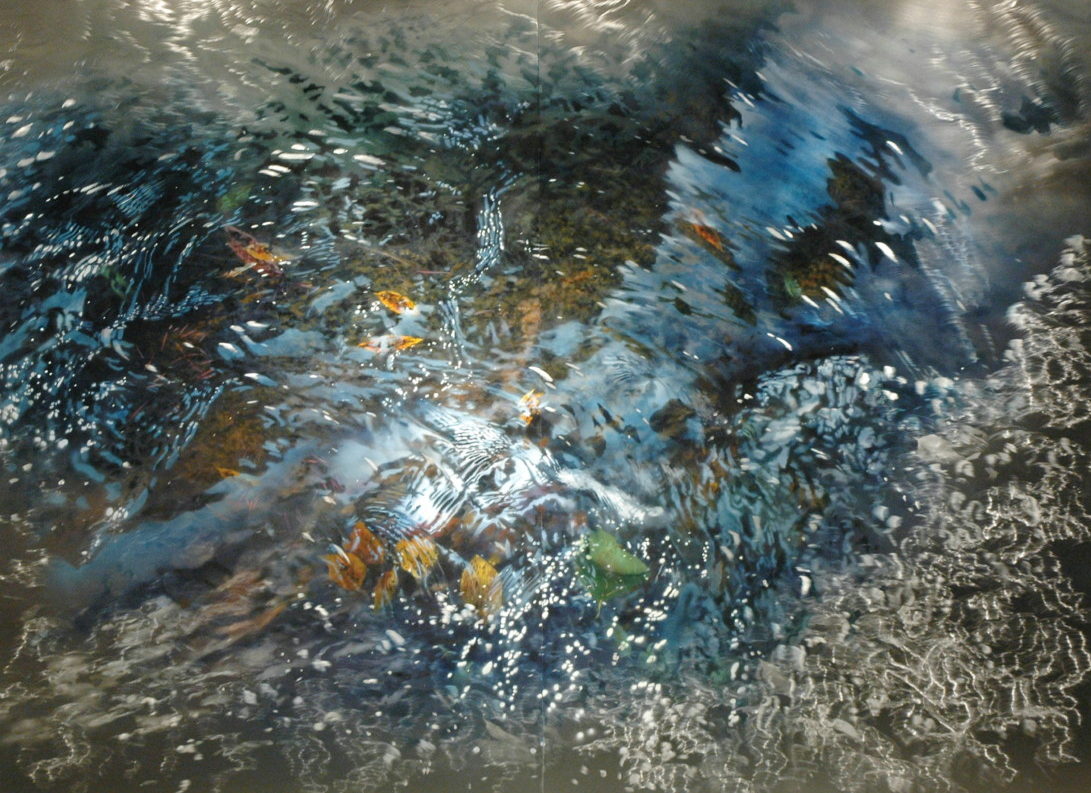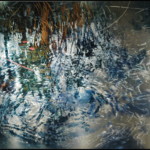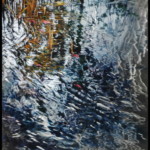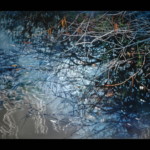Water-Inspired Paintings

Cover photo: “Silvered Overspill,” 72″x96″x1″
Left: “Shimmered Patterns,” 60″x84″x2″
Middle: “Reeds in Cadence,” 72″x48″x2″
Right:”Silvered Catsclaw,” 48″x84″x2″
Writer Beth Duckett
[dropcap]D[/dropcap]avid Kessler was a young graduate student at the San Francisco Art Institute when he was first introduced to the idea of photorealism.
In the art movement, which gained popularity in the 1960s and ’70s, artists re-create photographs in a hyper realistic way, capturing even the smallest details of a photo on canvas. Kessler, one of a dozen students accepted into the graduate program there, was drawn to the style almost immediately.
“In photorealism, basically whatever was on the slide went onto the canvas,” he says. “Once an artist picked the subject of the painting, he or she didn’t make any aesthetic choices for what would go on top of the canvas.”
Forty years later, Kessler continues the tradition as the basis for his famous waterscape paintings. Now an Arizona resident, the artist relies exclusively on photographic slides that he takes at iconic places throughout the state, from Sedona to Greer in northeastern Arizona, where he has a second home.
Shooting during the golden hour of photography, Kessler captures images of flowing eddies, swirling puddles and other slower-moving water bodies around the state.
“I don’t pride myself on being an excellent photographer,” Kessler says, laughing. “I just shoot hundreds and hundreds of slides. I go through the slides until I see an image that strikes me.”
“Maybe it just rained and there is a puddle off to the side,” Kessler describes. “I take a lot of my images from very small bodies of water.” It helps that the light in Arizona has a certain quality that you don’t see a lot in other places. “The clarity of the light here is just unbelievable,” he adds.
Since his days as a graduate student (he earned his master of fine arts degree in 1975), Kessler has refined the style of his work, which is featured in museums and galleries across the country. His paintings are a blend of abstract imagery and reality, captured inimitably over a surface of polished and abraded aluminum.
After the slides are taken, Kessler visits an industrial metal supply shop in Phoenix and selects a very thin piece of aluminum, ensuring there are no scratches. “The only scratches I want on the metal are the ones I add,” he says.
Kessler projects the slide images onto the piece of aluminum, using different tools, from a tiny jeweler’s brush to a drill, to create marks with different pressures. At that point, Kessler airbrushes paint onto the aluminum, either transparently or opaquely.
“I can do images where 70 percent of the image produced is by paint,” Kessler says, “Or I can do images where 70 percent is produced by refracted light.”
The result? A unique, visual experience that reflects the ethereal quality of the surface of water, transcending the everyday “paint-on-canvas” look.
“His work has a freshness and beauty that is quite grand,” longtime Kessler collector Dennis Frings remarks. “His paintings have a luminosity with the light coming at you from different perspectives both from the paint itself and the aluminum below. You are looking at a two-dimensional object, but it appears three-dimensional. It’s magic.”
Kessler, born in Park Ridge, New Jersey, moved at age 2 to Arizona, where he later attended Arizona State University before pursuing his graduate degree. Kessler and his family moved back to the Grand Canyon state in the 1980s.
It was shortly afterward that he created a body of work using “metalized paint and fine-art glitter to create these abstractions.” Kessler considered incorporating steel, a durable and malleable metal, onto his canvases, though the experiment didn’t go as planned.
“I got some steel and brought it back to my studio,” Kessler recalls. “The first thing I found out is that steel is very heavy. It’s not that soft of a metal. I thought I could articulate these marks on the metal.”
By chance, Kessler was working on some lithographs at the time, and had a piece of aluminum on hand. Unlike steel, aluminum “is a super, super soft metal,” he says. “You can actually take a Scott towel, put it on a piece of aluminum, and it will create a mark to refract light.
“Instead of putting little pieces of aluminum on my canvas, I thought, ‘Aluminum is going to take the place of my canvas now.’”
Using only small wired brushes, Kessler began to articulate various imageries onto the aluminum, creating a work through refracted light and “a slightly holographic depth-of-feel,” he says.
For a short time, the artist dabbled in abstract desert scenery, generating images that reflected all desert or half desert, half water. Later, he turned to water as the primary source for his work, calling it “a universal image”—and one that collectors around the world can recognize and appreciate.
Many of Kessler’s works are on display locally in an exhibit titled Translucence, featured at Desert Botanical Garden’s Ottosen Gallery through May 7. Elaine McGinn, director of planning and exhibits, says part of the garden’s mission is to “ensure it is a compelling attraction, that brings life to the many wonders of the desert.
“Visitors come to the garden expecting to be immersed in nature’s beauty, and David T. Kessler’s artwork captures a similar sentiment,” McGinn says. “Not only do his vividly real pieces demonstrate ingenious technique, but they also express simple yet stunning moments in nature—something guests experience when visiting the garden.”
Frings, who has collected Kessler’s work for more than 40 years, knew the artist as a photorealistic painter in the 1970s, when Kessler showed his paintings at a gallery in Alexandria, Virginia. Kessler’s work “was extraordinary then, just as it is now,” Frings says.
“His paintings always transcended the photorealist tradition and they have only grown more magical over the years,” the collector adds. “He just keeps getting better and better, and he started off at such a high level that that is no mean feat.”
480-481-8188
dbg.org




